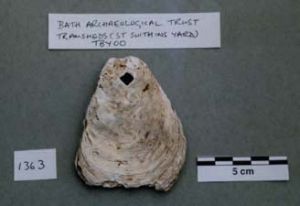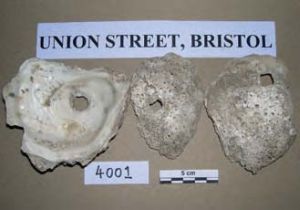|
Alex Menez’ observations and speculations regarding the square holes he has noted on oysters from archaeological contexts (Mollusc World 10) accord with thoughts I have had on the same subject. In the course of my work on marine mollusc assemblages from the archaeological record I see a fair number of holed oysters. Holes in oyster shells can be attributed to a wide range of agents. Many holes have no archaeological significance. Various microboring agents (Cliona spp., microalgae, microfungae) cause perforations at varying scales. Blistering resulting from the parasite Polydora causes progressive wear through the shell layers resulting in complete perforation of the shell. Excavation damage such as the perforation of shells by site-marking pegs must be distinguished from holes which were deliberately made during historic occupation of the site. (Quite apart from the fact that present-day holes will have fresh, relatively clean edges, the dimensions of the pegs used need to be known). Shells may be holed by trowelling during excavation. Flakiness of shells, sometimes exacerbated by prewashing, predisposes shells to holing. For all shells where some modification, whether natural or unnatural, has occurred its detection and interpretation are hampered when shells have been subjected to post-excavation washing prior to analysis, unless carried out in a controlled way. Whilst the removal of adherent soil allows some features to be discerned more clearly, the tendency to flaking is accelerated. Also, the removal of shell material which was weakly attached, including those fragments which may have been loosened or generated during excavation but remain attached, held in place by the soil, results in the loss of potentially useful information. When shells are washed, distinguishing between preexcavation and actual excavation damage is less straightforward but clearly, a shell bearing a hole with pristine margins unstained by soil is indicative of one that has been damaged during retrieval. But to return to the question of the square holes, there are at least three occasions when I believe I have handled oyster shells with holes similar to those described by Alex and which I infer have been made deliberately. From a Roman site in Bath I saw a right valve bearing a relatively large, square-sided hole at the umbo, and this is believed to be a manmade artefact, Figure C, p.15. From a Late Medieval site in Bristol I saw a large left valve of Ostrea edulis with a regular hole sited over the adductor scar. From this site there were also two other shells with square holes, Figure D, p.15. The appearance of these holes suggests they were buried as perforated shells. From a second Late Medieval site at Shapwick on the Somerset Levels I noted a right valve which was flat and lustrous with a central square sided hole (3mm). This shell also bears 2 V-shaped notches in marginal edge, these notches resulting from damage during opening of the oyster for consumption. The perforation to the shell suggests it was ‘re-cycled’ for a subsequent purposes. Alex wondered whether the oysters could have been used for roof tiles but had not seen a reference to this in the literature. In fact he has hit the nail on the head, as it were, for there is indeed a reference which hints on their possible use for this purpose. In writing up excavations carried out at the deserted Medieval village of Hangleton in East Sussex, Holden (1963) described perforated oysters shells as a persistent feature of finds assemblages containing pottery, tiles, roofing materials and nails and he figured some perforated oyster shells and a typical nail in his paper (Figure 39, page 175). As is often the case in matters of archaeological interpretation we need to combine an assessment of the tangible evidence with our experience and instincts as fellow humans and adopt a cautionary approach. A substantial deposit of oysters bearing similar, regular holes in an appropriate context would be grounds for considering their use as a roofing medium. But even as occasional finds, I would suggest that they could be used as a repair medium in a ‘patching’ capacity. Whatever these oyster shells mean, our ideas should be tempered by applying the Law of Least Astonishment! Holden, E.W. 1963. Excavations at the deserted medieval village of Hangleton. Sussex Archaeological Collections. 101. 54-177. |
Fig 1 Right valve of Ostrea edulis with square hole at the umbo, from a Roman site in Bath. Photo Jan LIght.
Fig 2 Three left valves of Ostrea edulis with holes believed to be manmade from a Late Medieval site in Bristol. Photo Jan Light. |
Oysters and Horseshoes – a reply
Issue
11
Page
18


